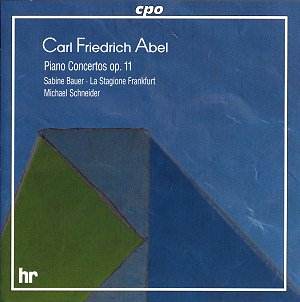There is probably a fine novel to be found in
the life story of Carl Friedrich Abel, one-time presumed student
of J. S. Bach, and friend, roommate, and business partner of Johann
Christian Bach in post-Handel London. Both men were extremely
talented and died young even for their day. And if this disk is
any example, we hope there will soon be not only books but more
music as well.
One could easily mistake this music for C.P.E.
Bach, but itís a little less stuffy, more playful, more inventive,
a bit more theatrical, but not quite as theatrical as that of
J. C. Bach. One can see how people were eager to believe that
Abel had studied with Bach ó but as he was a family friend, he
most surely studied Bach, if not with Bach. Abel had met
the young Mozart with his family, and later was interviewed by
the indefatigable Charles Burney. After the dissolution of his
London partnership Abel returned to Potsdam and enjoyed brief
popular success as a gambist before his death at the age of 54.
I have been critical of a previous recording
by these artists, observing that they pushed sprightly "authentic"
performance technique to the point of absurdity in the music of
G. M. Monn ó but this recording is absolutely beyond reproach.
These are lively but lyrical performances, beautifully played
in the best possible taste and the surest service to the composer
as well as the listener. The choice of instruments for the particular
concerti demonstrates that either would be practical for the whole
set, and captures the feeling of the time when the two instruments
were frequently heard side by side. Triple strings are used and
the cello is doubled by a violone, so these are played as true
orchestral concerti and not as trio sonatas. There is no separate
cembalo continuo, but, in the harpsichord concerti only, during
tutti string passages when there is no solo part, the soloist
plays continuo, emerging from that function to resume her solo
line. There is no information on the harpsichord, but for the
preceding to be true it must be a minimum two rank, two manual
instrument. Recording balance has been adjusted so that each instrument
is clearly audible and equally well placed within the orchestra.
This sounds to my ear like equal temperament,
and if I could have a reservation, it would be that I would have
preferred unequal temperament on both solo instruments. I have
been advised by violinists that it is easier to play in tune when
the keyboard instrument is unequally tempered.
Paul Shoemaker
